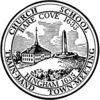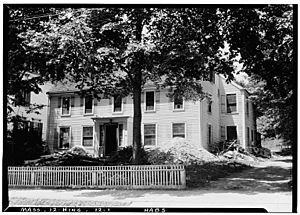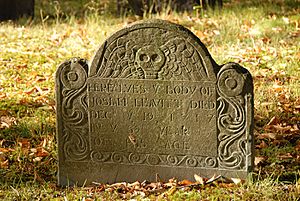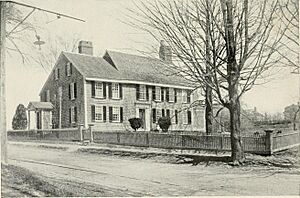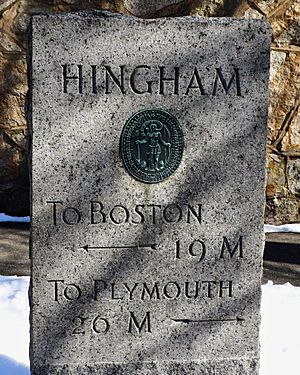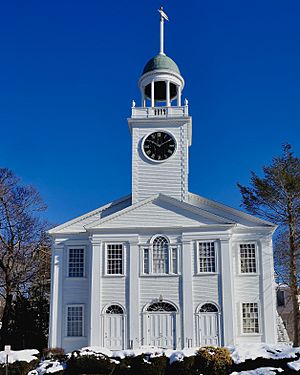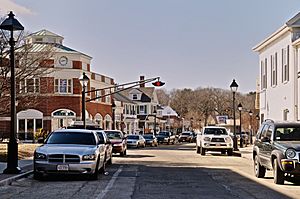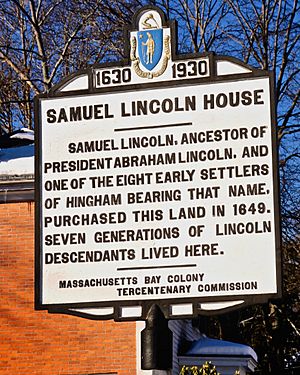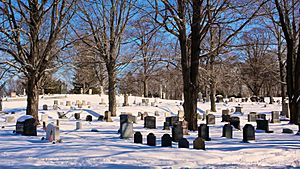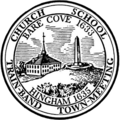Hingham, Massachusetts facts for kids
Quick facts for kids
Hingham
|
||
|---|---|---|
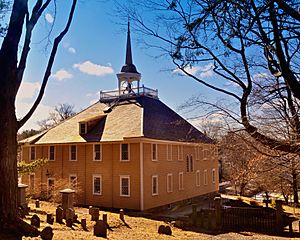
The Old Ship Church, Hingham
(Seventeenth-century English Colonial architecture) |
||
|
||
| Nickname(s):
"Bucket Town"
|
||
| Motto(s):
"History and Pride"
|
||
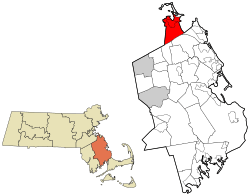
Location in Plymouth County in Massachusetts
|
||
| Country | United States | |
| State | Massachusetts | |
| County | Plymouth | |
| Settled | 1633 (as Bare Cove) | |
| Incorporated | September 2, 1635 | |
| Government | ||
| • Type | Open town meeting | |
| Area | ||
| • Total | 26.3 sq mi (68.1 km2) | |
| • Land | 22.2 sq mi (57.5 km2) | |
| • Water | 4.1 sq mi (10.6 km2) | |
| Elevation | 60 ft (18 m) | |
| Population
(2020)
|
||
| • Total | 24,284 | |
| • Density | 923.6/sq mi (356.59/km2) | |
| Time zone | UTC-5 (Eastern) | |
| • Summer (DST) | UTC-4 (Eastern) | |
| ZIP Code |
02043
|
|
| Area code(s) | 339/781 | |
| FIPS code | 25-30210 | |
| GNIS feature ID | 0618342 | |
| Website | Hingham, Massachusetts | |
Hingham (/ˈhɪŋəm/ HING-əm) is a town in northern Plymouth County, Massachusetts. It is part of the Greater Boston area. Hingham is located on the South Shore of Massachusetts.
In 2020, the town had a population of 24,284 people. Hingham is famous for its old colonial history. It is also known for its location on Boston Harbor. The town was named after Hingham, Norfolk, England. English colonists first settled here in 1633.
| Top - 0-9 A B C D E F G H I J K L M N O P Q R S T U V W X Y Z |
Hingham's Story: A Look at Its History
The first English colonists called the area "Bare Cove" in 1633. Two years later, in 1635, it officially became a town named "Hingham." The land was given to the English by Wompatuck, a leader of the Wampanoag people, in 1655.
Hingham was part of Suffolk County until 1803. After that, it became part of Plymouth County. In 1770, the eastern part of Hingham became its own town, Cohasset. The town was named after Hingham, England. Many of the first colonists came from there. This included Abraham Lincoln's ancestor, Samuel Lincoln, who arrived in 1637. A statue of President Lincoln is near downtown Hingham Square.
Hingham was founded because of religious disagreements. Many early settlers had to leave their homes in England. Their church leaders, Reverend Peter Hobart and Reverend Robert Peck, had problems with the strict rules of the Church of England. Peck was known for his strong Puritan beliefs. He made changes to the church building that upset authorities.
Hobart, who was born in Hingham, England, also followed Puritan ideas. He and Peck had studied at Magdalene College, Cambridge. The people who moved to America paid a high price. They "sold their possessions for half their value," a writer at the time said. They named their new home after their old one. The town they left behind also suffered. It had to ask for help because so many wealthy citizens had left.
Most early Hingham settlers came from East Anglia, England. However, some, like Anthony Eames, came from the West Country. There were some disagreements between these different groups in Hingham's early years. One conflict in 1645 involved the town's local militia, called a "trainband." Some settlers supported Eames, while others supported Bozoan Allen. This argument became so serious that important leaders like John Winthrop had to get involved.
Even though the town was formed in 1635, the colonists did not buy the land from the Wampanoag people until 30 years later. On July 4, 1665, the Wampanoag chief, Josiah Wompatuck, sold the land to Captain Joshua Hobart and Ensign John Thaxter. These men represented Hingham's colonial residents. The colonists had lived on the land for a long time.
The payment for the land was handled by two Hingham landowners. These were Lieutenant John Smith and Deacon John Leavitt. They had been given 12 acres (about 4.9 hectares) on Hingham's Turkey Hill earlier that year. They were told to pay Josiah Wompatuck for their land grant. This payment also covered the cost of the entire town's land.
The third town clerk of Hingham was Daniel Cushing. He moved to Hingham from Hingham, England, in 1638. Cushing kept very detailed records of early Hingham. These records helped later historians learn a lot about the town's first years and its families. Cushing even included town gossip in his official notes!
Hingham's Location and Natural Beauty
Hingham covers a total area of about 68.1 square kilometers (26.3 square miles). About 57.5 square kilometers (22.2 square miles) is land. The remaining 10.6 square kilometers (4.1 square miles), or 15.58%, is water.
Hingham is surrounded by other towns. To the east are Cohasset and Scituate. To the south are Norwell and Rockland. To the west is Weymouth. To the north are Hingham Bay and Hull. Hingham is about 14 miles (23 km) southeast of Boston.
Hingham is located on the southwestern edge of Boston Harbor. The harbor forms a U-shaped curve along the town's northern coast. The Weir River separates Hingham from Hull. This river flows into Straits Pond. The Weymouth Back River forms part of Hingham's border with Weymouth. It also flows into Hingham Bay.
The town has several small ponds and streams. There are also many forests and parks. The largest is Wompatuck State Park. It extends into the nearby towns of Cohasset, Scituate, and Norwell. Hingham also has several protected natural areas. Part of the Boston Harbor Islands National Recreation Area is in Hingham. This includes islands like Bumpkin Island and World's End Reservation. World's End is a peninsula that reaches into the bay. There is a marina (a place for boats) near the Weymouth Back River. Hingham also has a public beach along the harbor.
Hingham's People: Demographics
| Historical population | ||
|---|---|---|
| Year | Pop. | ±% |
| 1850 | 3,980 | — |
| 1860 | 4,351 | +9.3% |
| 1870 | 4,422 | +1.6% |
| 1880 | 4,485 | +1.4% |
| 1890 | 4,564 | +1.8% |
| 1900 | 5,059 | +10.8% |
| 1910 | 4,965 | −1.9% |
| 1920 | 5,604 | +12.9% |
| 1930 | 6,657 | +18.8% |
| 1940 | 8,003 | +20.2% |
| 1950 | 10,665 | +33.3% |
| 1960 | 15,378 | +44.2% |
| 1970 | 18,845 | +22.5% |
| 1980 | 20,339 | +7.9% |
| 1990 | 19,821 | −2.5% |
| 2000 | 19,882 | +0.3% |
| 2010 | 22,157 | +11.4% |
| 2020 | 24,284 | +9.6% |
| 2022* | 24,130 | −0.6% |
| * = population estimate. Source: United States Census records and Population Estimates Program data. | ||
In 2020, Hingham had 24,284 people and 8,873 households. The population density was about 884.8 people per square mile (341.6 per square kilometer).
Most of the people in Hingham are White (97.5%). Other groups include Black or African American (0.40%), Native American (0.04%), and Asian (0.88%). About 0.75% of the population is Hispanic or Latino.
About 37.8% of households had children under 18 living with them. Most households (65.7%) were married couples. About 21.0% of households were single individuals. The average household had 2.72 people.
The population's age range was spread out. About 27.7% were under 18 years old. About 14.1% were 65 years or older. The average age in Hingham was 40 years.
In 2019, the average household income was $142,435. The average family income was $198,900. The income per person in the town was $78,301. About 3.5% of the population lived below the poverty line. This included 4.7% of those under 18.
Hingham's Economy: Major Employers
Hingham has many businesses that provide jobs. Here are some of the top employers in the town, based on a 2017 report:
| # | Employer | # of employees |
|---|---|---|
| 1 | Blue Cross/Blue Shield | 1,456 |
| 2 | Town of Hingham | 985 |
| 3 | Linden Ponds | 802 |
| 4 | Talbots | 461 |
| 5 | Serono Laboratories | 437 |
| 6 | Harbor House | 247 |
| 7 | Whole Foods | 212 |
| 8 | Stop & Shop | 196 |
| 9 | Russ Electric | 191 |
| 10 | Eat Well | 170 |
Infrastructure: Schools and Transportation
Education in Hingham
Hingham has a strong education system. It is home to seven public schools:
- Hingham High School
- South Shore Educational Collaborative
- Hingham Middle School
- East Elementary School
- Foster Elementary School
- Plymouth River Elementary School
- South Elementary School
There are also five private schools in Hingham:
- Derby Academy
- Notre Dame Academy
- St. Paul School
- Old Colony Montessori School
- Su Escuela Language Academy
Getting Around Hingham: Transportation
Several major roads pass through Hingham. A small part of Route 3 goes through the southwest. Routes 3A and 53 also cross the town. Route 228 runs north to south.
Hingham has public transportation options. There is a commuter boat ferry service. It goes from Hingham Shipyard to Rowes Wharf in downtown Boston. The MBTA also runs Bus Route 220. Route 222 passes through a small part of town.
The MBTA Commuter Rail also serves Hingham. It connects to Boston South Station via the Greenbush Line. Trains stop at two stations in Hingham: West Hingham and Nantasket Junction. A tunnel was built to carry the trains under historic Hingham Square. This was part of the agreement to bring train service back.
During the summer, ferries also go from Hingham Shipyard to several islands in Boston Harbor. They also go to Pemberton Point in Hull. Hingham does not have its own airport. The closest major airport is Logan International Airport in Boston.
Famous People from Hingham
Hingham is connected to many notable people. One famous family line is the Lincolns. They came from England in the 1600s. A bridge in Hingham is named after General Benjamin Lincoln. He was a general in the American Revolutionary War. He is known for accepting the surrender of Cornwallis at the Siege of Yorktown.
The most famous Lincoln connected to Hingham never lived there. This was United States President Abraham Lincoln. He was a descendant of one of the Lincoln families who settled in Hingham. A bronze statue of President Lincoln is located near Lincoln Street and North Street.
Other notable people from Hingham include:
- Tony Amonte, a retired hockey player in the NHL.
- Bill Belichick, a famous football coach, owns a house in Hingham.
- Matty Beniers, a current ice hockey player in the NHL. He was the first draft pick for the Seattle Kraken.
- Marc Brown, the author and illustrator who created the children's TV show Arthur.
- David McCullough, a well-known author and historian.
- Pierre McGuire, an ice hockey analyst and former coach.
Images for kids
See also
 In Spanish: Hingham (Massachusetts) para niños
In Spanish: Hingham (Massachusetts) para niños


